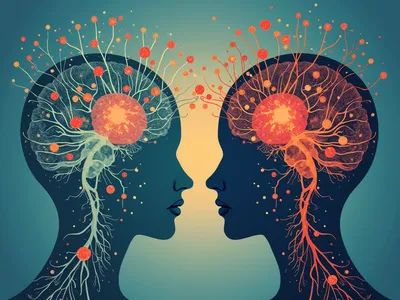
How does the activity of mirror neurons differ between monolinguals and bilinguals when learning Russian
The activity of mirror neurons in monolinguals and bilinguals, particularly when learning Russian, presents intriguing differences based on language processing and cognitive engagement.
Differences in Mirror Neuron Activity
Monolinguals vs. Bilinguals
-
Cognitive Load: Bilingual individuals often experience a higher cognitive load when processing a second language compared to monolinguals. This increased demand can lead to more pronounced activation of the mirror neuron system as bilinguals engage in observing and producing language, which requires additional neural resources for language switching and integration of linguistic structures from both languages 1, 4.
-
Language Proficiency: The proficiency level in the second language significantly impacts mirror neuron activity. In a study involving bilinguals with advanced English proficiency (B2 or C1 levels), it was found that their mirror neurons were more active when pronouncing words in both their native (Russian) and non-native languages (English) compared to monolinguals who had limited exposure to English (A1 or A2 levels). This suggests that higher proficiency leads to more efficient neural processing and greater engagement of the mirror neuron system during language tasks 1, 4.
Types of Bilingualism
- Sequential vs. Simultaneous Bilingualism: The type of bilingualism also plays a role in how mirror neurons are activated. Sequential bilinguals, who learn a second language after establishing their first, may show different patterns of neural activation compared to simultaneous bilinguals, who acquire both languages from an early age. The former might rely more heavily on their native language’s neural pathways, while the latter could exhibit a more integrated neural response across both languages 1, 4.
Implications for Language Learning
Learning Mechanisms
-
Imitation and Social Cognition: Mirror neurons facilitate imitation and understanding social cues, which are crucial for language acquisition. Bilingual learners may leverage these mechanisms more effectively due to their experience with multiple languages, enhancing their ability to mimic pronunciation and grasp linguistic nuances in Russian 7, 13.
-
Emotional Engagement: The emotional context of words can also influence mirror neuron activity. Studies indicate that bilinguals may engage differently with emotional versus non-emotional words in both their native and learned languages, suggesting that emotional engagement can modulate the effectiveness of mirror neuron activation during language learning 1, 4.
Neural Plasticity
- Adaptation and Restructuring: Learning a second language like Russian involves significant neural plasticity. Bilinguals often exhibit changes in brain structure associated with enhanced cognitive functions, which may be reflected in the adaptability of their mirror neuron systems as they navigate between languages 4, 17.
In conclusion, the activity of mirror neurons differs notably between monolinguals and bilinguals learning Russian. Bilinguals tend to show greater neural engagement due to the complexities involved in managing multiple languages, leading to enhanced cognitive flexibility and potentially richer language learning experiences.
References
-
Studies of speech processes in monolinguals, bilinguals and multilinguals
-
AUTISM SPECTRUM DISORDER IN CHILDREN: DIAGNOSTIC SIGNIFICANCE OF ELECTROENCEPHALOGRAPHY
-
“Looking-Glass” as a method in the methodology of RFL: the case of Indonesian-Russian Interlanguage
-
Pedagogical discourse of a bilingual - future teacher of the Russian language
-
Bilingual dictionaries in teaching Russian to Persian-Speaking students: relevancy and problems
-
Understanding the Role of Mirror Neurons in Learning Language: A Review of Studies
-
МАТЕРИАЛЫ К ТОЛКОВОМУ СЛОВАРЮ ЯЗЫКА КАЛМЫЦКОГО ГЕРОИЧЕСКОГО ЭПОСА «ДЖАНГАР»: НА ПРИМЕРЕ ЛЕКСЕМЫ ҺАЛ
-
Challenges for Urban Environments in the Implementation of Dual Language Programs
-
English L3 acquisition in heritage contexts: Modelling a path through the bilingualism controversy
-
Emotion, Mirror, and Reward: Reconsidering the Russian Doll Model
-
COGNITIVE PROCESSING OF THE GRAMMATICAL GENDER OF RUSSIAN NOUNS IN DIFFERENT TYPES OF BILINGUALISM
-
AUTISM SPECTRUM DISORDER IN CHILDREN: DIAGNOSTIC SIGNIFICANCE OF ELECTROENCEPHALOGRAPHY
-
Case system in learning Russian as a first and second foreign language
-
Are the Roma children “Mentally retarded” if they do not Know the Syntax in their Second Language?